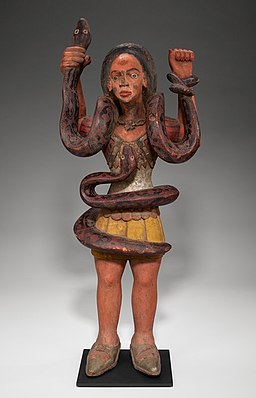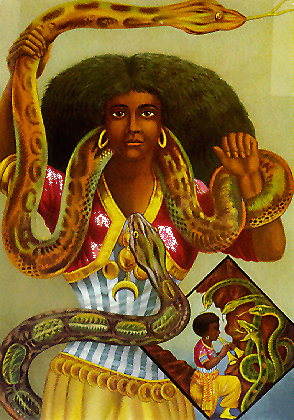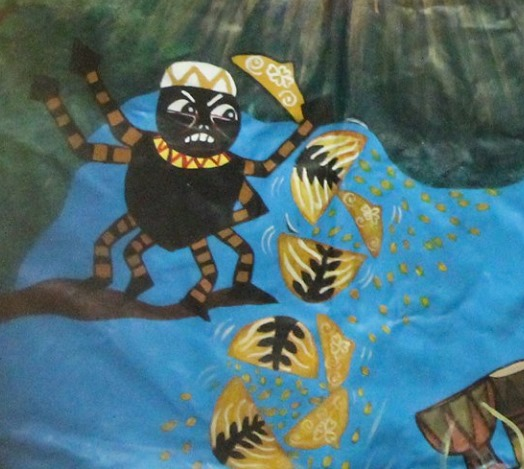Most of us have grown up listening to folktales, which serve to teach us lessons in bravery, wisdom, friendships, and also as warnings. We have laughed and listened breathlessly to these stories as they were told by our older cousins, siblings, parents, and grandparents. So let’s get into some of these folktales from Africa and the Diaspora.
Folktales about mermaids are popular across Africa and the Diaspora. They are beings that can be gentle, representing water deities, or they can be fierce, drowning ships and sailors pulling them into the depths of the ocean. One mermaid folktale is that of ‘Mama D’Leau’ from Trinidad and Tobago. Her story is said to be influenced by the folklore of ‘Mama Wata’ from West and Central Africa. As well as Oshun, who is an orisha(deity) from the Yoruba religion. ‘Mama D’Leau’ is also known as ‘Mama Glo or Mama Dlo’ and is a folklore character who appears in the form of a beautiful woman, with long hair and a fish-like tail who lives in rivers. Her name is derived from the french, ‘Maman de L’eau’ which means mother of the water. She is a healer and protector of all river animals and usually appears in the stories sitting on a rock in the river combing her hair with a gold comb. As the stories go, when she gets angry she becomes more serpent-like, her hair turning into live snakes.


A poster of Mama Wata from the 1800’s on the right| Public Domain via Wikimedia commons
The stories of Anansi from the Ashanti Tribe in Ghana is one of the most popular folktales. Anansi is a folktale character that often appears in the stories like a spider. Anansi often takes on the role of a trickster and is known for his cunning wit, creativity, and ability to turn anything to his advantage. Due to the Atlantic slave trade, Anansi stories spread and are still popular in various countries. In South Carolina, he is known as Aunt Nancy and Annancy, or Anancy in Jamaica, Grenada, Costa Rica, and Nicaragua to name a few of the countries where Anansi Folktales are still popular.

Photo Credit: Biblioteca Juvenil Mayaguez, CC BY-SA 4.0
Some stories, on the other hand, stress the importance of caring, virtue, and being kind. Stories such as ‘Selekana and the River God’ from Botswana is an example of this. The story goes that there was a girl called Selekana who lived in Botswana. She was caring, generous, and considered beautiful inside and out. One day she helped an old woman carry some water, and the woman was so thankful that she took off her necklace and gave it to Selekana. The necklace was spectacular, its jewels a dazzling blue that was said to belong to the river god. The necklace was so beautiful, however, that all the other girls got envious, and they devised a plan to get the necklace away from Selekana. They told her that they had all dropped their necklaces into the river as a sacrifice and that she too should drop hers. Selekana was always trusting and did as they said, and was shocked as they started shrieking in her face that they had tricked her into losing her necklace. But all was not lost. Selekena was distraught and was crying by the river, when suddenly a beautiful woman appeared out of the water, dressed all in blue. The woman was the River God and after calming Selekana down, guided her into the water where her river palace lied. In the palace, the river god gave her a box full of precious jewels and necklaces because she could see that Selekana had a pure heart. Hence, the moral of the story is that good hearts and deeds never go unseen.
Some folktales inspire, they teach us between right and wrong, and some tell us of sinister characters lurking in the woods or the depths of the sea ready to pry on us. One such character is the Soucouyant, who is often portrayed as an old woman. The Soucouyant can shed her skin and transform into a ball of fire and sucks people’s blood. The only way one can protect themselves from the Soucouyant is to either strew rice around your bed or at the entrance of the house or to sprinkle salt on the shed skin. The rice is a protection measure because the Soucouyant will be compelled to stop and count the pieces of rice, giving the person time to run or to arm themselves. The story of the Soucouyant or old hag is told in the Bahamas, Barbados, Guyana, Jamaica, and Trinidad and Tobago. The Douen is a Trini folklore that is sure to send shivers down your spine. The Douen, are the spirits of a child who died before they were baptized. They are often dressed in big hats and have backward-facing feet. They often utter a cry and try to lure children to wander off.
https://www.youtube.com/watch?v=2AEK_DzUZaY&feature=emb_logo
Folktales from Africa and the Diaspora have been told for centuries, carried down through generations, and kept alive in communities through oral tradition. If you are interested in learning more about folktales from the diaspora, there are several podcasts such as the African Folktales podcast or you can read World of Tales which has a list of folktales.
Powered by WPeMatico


